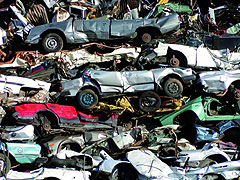Congress cranks clunkers cash scheme
BY RON HAMMERTON | 11th Jun 2009

The bill’s passage through the Senate and into law now seems a formality, as Democrats and Republicans alike voted overwhelmingly – 298 to119 – in support of the CARS Act, which also has the support of the Obama administration.
Strangely, the news caused barely a ripple on US news services, unlike the UK and Europe where the introduction of similar schemes brought front-page headlines.
The bill sets aside $4 billion ($A5 billion) to provide electronic vouchers towards new, more fuel-efficient cars and pick-ups for owners of older cars whose vehicles will then be crushed without any trade-in value.
Although there is a chance that the bill could be modified in the Senate, customers are likely to get a $US3500 ($A4320) voucher if they trade in a passenger car that gets less than 18mpg (13.0L/100km) for a new car getting at least 22mpg (10.7L/100km).

Congressional estimates suggest the incentives could generate thousands of jobs in the depressed US car industry while taking some of the worst-offending gas-guzzlers and polluters off the roads.
The Congressional Budget Office says the bill could spur sales of about 625,000 vehicles, but backers – particularly from car industry-heavy states such as Michigan and Ohio – are hoping for one million Unlike European schemes, the bill so far has no age limit on cars being scrapped, with proponents of the US scheme saying the fact that the trade-in cars must be crushed without any trade-in value will be self-governing, as no one is going to crush a valuable car.
The vehicles also have to have been registered for a minimum of 12 months before being traded.
However, critics say the system will be rorted, with unscrupulous operators transferring build plates and stripping out engines and other valuable parts before pushing the cars into the crusher.
They are also concerned that such schemes simply pull-forward sales, leading to a demand vacuum once the scheme runs out.
In Australia, the federal government has rejected calls for a similar scheme, preferring instead to offer business tax incentives. Last month, sales of utilities jumped, suggesting that the scheme is having some effect.
Scrappage schemes in Europe have been credited with big gains in car sales. In Germany, car volumes were up almost 40 per cent last month compared with May last year, while France recorded an 11.9 per cent rise.
In Britain, where a scheme was introduced in mid May, results were less obvious, with sales still down 24.8 per cent for the entire month. This was, however, better than the 27.9 per cent slide for the first five months of the year.
In the US, an estimated 25 million vehicles will qualify for the scrappage scheme, but most are light trucks – pick-ups and large SUVs.
The US government is concerned that its large investment in saving General Motors and Chrysler from bankruptcy could falter unless the market is stimulated in the showrooms.
Read more:
‘Cash for clunkers’ scheme closer in USMixed sales results in Europe